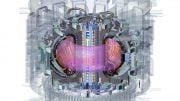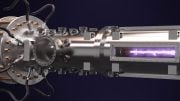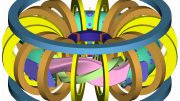Scientists have found a novel way to prevent pesky magnetic bubbles in plasma from interfering with fusion reactions – delivering a potential way to improve the performance of fusion energy devices. And it comes from managing radio frequency (RF) waves to stabilize the magnetic bubbles, which can expand and create disruptions that can limit the performance of ITER, the international facility under construction in France to demonstrate the feasibility of fusion power.
Magnetic islands
Researchers at the U.S. Department of Energy’s (DOE) Princeton Plasma Physics Laboratory (PPPL) have developed the new model for controlling these magnetic bubbles, or islands. The novel method modifies the standard technique of steadily depositing radio (RF) rays into the plasma to stabilize the islands — a technique that proves inefficient when the width of an island is small compared with the characteristic size of the region over which the RF ray deposits its power.
This region denotes the “damping length,” the area over which the RF power would typically be deposited in the absence of any nonlinear feedback. The effectiveness of the RF power can be greatly reduced when the size of the region is greater than the width of the island — a condition called “low-damping” — as much of the power then leaks from the island.
Tokamaks, doughnut-shaped fusion facilities that can experience such problems, are the most widely used devices by scientists around the world who seek to produce and control fusion reactions to provide a virtually inexhaustible supply of safe and clean power to generate electricity. Such reactions combine light elements in the form of plasma — the state of matter composed of free electrons and atomic nuclei that makes up 99 percent of the visible universe — to generate the massive amounts of energy that drives the sun and stars.
Overcoming the problem
The new model predicts that depositing the rays in pulses rather than steady state streams can overcome the leakage problem, said Suying Jin, a graduate student in the Princeton Program in Plasma Physics based at PPPL and lead author of a paper that describes the method in Physics of Plasmas. “Pulsing also can achieve increased stabilization in high-damping cases for the same average power,” she said.
For this process to work, “the pulsing must be done at a rate that is neither too fast nor too slow,” she said. “This sweet spot should be consistent with the rate that heat dissipates from the island through diffusion.”
The new model draws upon past work by Jin’s co-authors and advisors Allan Reiman, a Distinguished Research Fellow at PPPL, and Professor Nat Fisch, director of the Program in Plasma Physics at Princeton University and associate director for academic affairs at PPPL. Their research provides the nonlinear framework for the study of RF power deposition to stabilize magnetic islands.
“The significance of Suying’s work,” Reiman said, “is that it expands considerably the tools that can be brought to bear on what is now recognized as perhaps the key problem confronting economical fusion using the tokamak approach. Tokamaks are plagued by these naturally arising and unstable islands, which lead to disastrous and sudden loss of the plasma.”
Added Fisch: “Suying’s work not only suggests new control methodologies; her identification of these newly predicted effects may force us to re-evaluate past experimental findings in which these effects might have played an unappreciated role. Her work now motivates specific experiments that could clarify the mechanisms at play and point to exactly how best to control these disastrous instabilities.”
Original model
The original model of RF deposition showed that it raises the temperature and drives current in the center of an island to keep it from growing. Nonlinear feedback then kicks in between the power deposition and changes in the temperature of the island that allows for greatly improved stabilization. Governing these temperature changes is the diffusion of heat from the plasma at the edge of the island.
However, in high-damping regimes, where the damping length is smaller than the size of the island, this same nonlinear effect can create a problem called “shadowing” during steady state deposition that causes the RF ray to run out of power before it reaches the center of the island.
“We first looked into pulsed RF schemes to solve the shadowing problem,” Jin said. “However, it turned out that in high-damping regimes nonlinear feedback actually causes pulsing to exacerbate shadowing, and the ray runs out of power even sooner. So we flipped the problem around and found that the nonlinear effect can then cause pulsing to reduce the power leaking out of the island in low-damping scenarios.”
These predicted trends lend themselves naturally to experimental verification, Jin said. “Such experiments,” she noted, “would aim to show that pulsing increases the temperature of an island until optimum plasma stabilization is reached.”
Reference: “Pulsed RF schemes for tearing mode stabilization” by S. Jin, N. J. Fisch and A. H. Reiman, 9 June 2020, Physics of Plasmas.
DOI: 10.1063/5.0007861
Funding for this research comes from the DOE Office of Science.










Yes, I am from Japan. At least now I am also angry about the Chinese invading and threatening neighboring countrues and the rest of the world and murdering or oppressing the Uyghurs, Tibetans and Inner Mongolians and violating the Paris accord.
Chinese is not a race but a nationality. Anyone of any race can be Chinese.
Even though many Chinese in America are not spies themselves, they can be allies of chinese spies.
Mitsuki Kimura, you are angry about the Chinese invading and threatening neighboring countries and the rest of the world so you resort to racist name calling ? Ok, shall we talk about Japan’s past and the invading they have done ? Let me know when you want to start the conversation.
Technically it is nationalist not racist.
All regarding the Japan’s past and the invading have been settled and resolved by San Francisco Peace treaty.
Why don’t people understand this fission energy system is going to cost everyone way more than it would have cost by using coal gas or oil and dam hydro plants
There is going to be waste from these costly fusion plants they are not telling us about, Just wait and the cost of paying fr energy will be out of reach for the average person, Then just watch for break downs, To many things involved in this type of process.
BS, fusion is not economically feasible.
The vast majority of fusion articles are promotional in nature and typically the journalists never bother to seek out countering viewpoints. Most fans of fusion power are likely clueless regarding the issues presented in the following article.
ITER is a showcase … for the drawbacks of fusion energy
https://thebulletin.org/2018/02/iter-is-a-showcase-for-the-drawbacks-of-fusion-energy
Not very sure actually.
The question about the microwave emitter might be the frequency and amplitude of the carrier then the abililty to control (vary) the pulse (frequency) repetition rate firing the carrier.
Go kill yourself idiot! Why my parents generation is guilty means I am guilty too? Are you arrested if your parents committed a crime?
And it should be called a nationalist propaganda not a racist propaganda if you call it a propaganda after all.
Hoo my…!
Let’s start a new adult conversation about fusion energy..?
So back too tokamak machine’s we are now only 10 years away from making it work.? We have heard that old one before.
Odd question ‘ does anyone know what we actually do with all that helium-3 stuff from off the moon ?’ just curious.